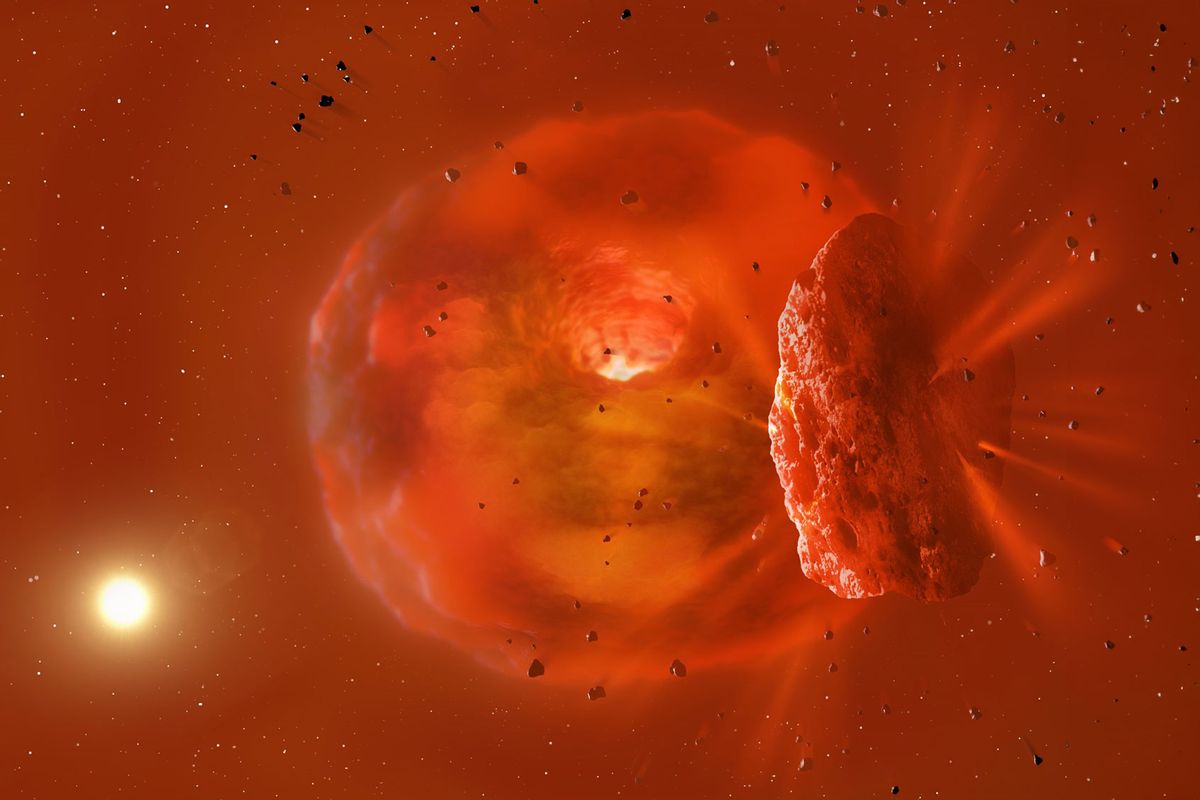It's a bit mind-boggling to imagine something as big as the planet Neptune crashing into a similar-sized planet, but astronomers caught this exact scenario, as described in a recent study in the journal Nature. A pair of ice giants — or massive planets the size of Uranus and Neptune, but composed of elements that are heavier than hydrogen and helium — collided into each other as they passed in front of the star they orbit, ASASSN-21qj. (If you say the name of the star ASASSN-21qj aloud, it sounds a bit like "assassin.")
ASASSN-21qj is described as an "otherwise unexceptional" star, but thanks to a tip from an amateur astronomer, it was observed being obscured by two of its own planets as they demolished one another. As they did so, they released a giant cloud of debris that ultimately managed to dim astronomers' ability to view the distant star, which is 1,800 light-years away from Earth.
This cloud of kicked-up matter formed a new, extremely hot, spinning object that may be hundreds of times larger than Earth. This is the first time that astronomers have ever seen the aftermath of such a planetary collision.
Arttu Sainio — a citizen scientist who volunteers for NASA — decided to analyze past ASASSN-21qj observations using images from the agency's Neowise mission (an infrared space telescope), according to The Guardian. He had felt prompted to do so in response to a tweet by Dr. Matthew Kenworthy from the Netherlands' Leiden Observatory, who had asked for images of shadows cast by giant rings around planets as they orbit their parent stars. Instead of those discoveries, however, Sainio drew attention to something altogether different: ASASSN-21qj had been emitting a strange light output, one in which the infrared light increased twofold in intensity before fading into visible light a mere three years later.
“I was looking for something completely different,” Kenworthy later told The Guardian. “The infrared brightening told us something unusual had happened in the neighbourhood of this star, and so it took us down this new path.” (Kenworthy later helped lead the study, which also credits Sainio as a co-author.)
Merely identifying the unusual light output was nowhere near enough. In order to identify what they had just observed, researchers had to utilize the technology offered by the Wide-field Infrared Survey Explorer (WISE) satellite, which further monitored ASASSN-21qj and its environs on infrared. The scientists ultimately ruled out two other hypotheses — one that there had been a "warm-dust-generating collision within 0.1 [astronomical unit] of the star, with a separate object transiting the star 900 days later," which was dismissed as too unlikely; and the other that "warm dust is generated close to the star" and caused the optical effect, a theory that was ultimately dismissed for technical reasons.
The scientists also continued their astronomical observations of ASASSN-21qj for two years, watching and recording as its brightness fluctuated. Additionally, a computer model was created to simulate what the collision would have been like, which supplemented the scientists' other observations and helped them hypothesize that the resulting debris formed a large body.
Want more health and science stories in your inbox? Subscribe to Salon's weekly newsletter Lab Notes.
This is the first time that astronomers have ever seen the aftermath of such a planetary collision, which came to their attention thanks to a tip from an amateur astronomer.
"Our calculations and computer models indicate the temperature and size of the glowing material, as well as the amount of time the glow has lasted, is consistent with the collision of two ice giant exoplanets," co-lead author Simon Lock, a researcher at the University of Bristol, explained in a statement. They confirmed that they had indeed witnessed what astronomers refer to as a "giant impact," or (to quote the paper) "a single collision between super-Earths or mini-Neptunes" that amounts to "one of the most energetic events that planets can experience."
There will be further research into this planetary collision and the star around which it transpired. NASA scientists and others plan on studying ASASSN-21qj and the planetary debris caused by the collision over future years, particularly as the debris cloud continues to spread out along the orbit of the erstwhile planets. Scientists also plan on utilizing the potential of the James Webb Space Telescope, particularly to capture light as it scatters off of the dust cloud. Ground-based observatories like those used for the research in this paper will also be heavily utilized.
Study co-author Zoë Leinhardt, an associate professor of Astrophysics at the University of Bristol, said in a statement that "it will be fascinating to observe further developments. Ultimately, the mass of material around the remnants may condense to form a retinue of moons that will orbit around this new planet."



Shares